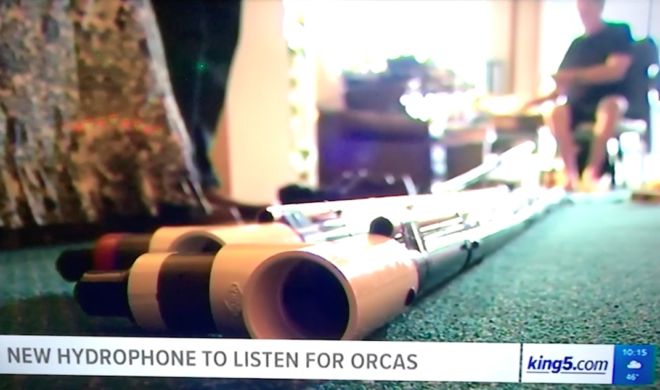As of Monday (12/16/2019), new and vastly improved hydrophones are now operating at Bush Point B&B on Whidbey Island. Because the old hydrophone had become increasingly insensitive during 2019, this upgrade restores our ability to listen for whales in this key location. Half way into Admiralty Inlet, Bush Point is on the primary route to/from Puget Sound and the Whidbey Basin (Edmonds to Deception Pass) where orcas, humpbacks, and gray whales often travel.
You can listen live 24/7 at: https://live.orcasound.net/bush-point
You can help with future improvements to the Bush Point hydrophones! Donate to Orca Network’s Ocean Listening Project, or sign up to be an Orca Network volunteer.

Florian, Lon, & Howie get ready. 
Lon & Howie lower hydrophones to Florian during a winter low-tide. 
New array deployed! 
Lynn and Lon atop the Bush Point wharf above the new 3-hydrophone array.
The new hydrophones were built and installed by Lon Brocklehurst of Lab-core System, based in Olympia, with logistical help from Whidbey Island’s local marine cinematographer, Florian Graner of Sealife Productions. The upgrade was a collaborative effort of four members of the Orcasound hydrophone network: the node host organization Orca Network managed the effort; Lab-Core System built the new array and led the installation; Beam Reach provided technical support with live-streaming; and the Center for Whale Research helped coordinate the original hydrophone array design and deployment plan.
The high-speed Internet connection is supported through a generous grant from Whidbey Telecom. The hydrophones are deployed from the Bush Point Wharf B&B thanks to the generosity of owner Stan Yu. Lynn Carey helped document the deployment by taking some great photos.

Close-up of the new hydrophones. 
Howard talks orca. 
Bush Point B&B wharf provides ocean access. 
Lon Brocklehurst discusses his hydrophone system with Howard Garrett.
The new array has three hydrophones and is deployed near the outer edge of the Bush Point wharf. On Lon’s hydrophone system, the left channel is located furthest south (aka channel #1 or T-1), the right channel is located furthest north (aka channel #3 or T+1), and the center channel (not streamed) is centrally located on the SW corner of the wharf (aka channel #2 or T=0). The physical separation between the hydrophones in the left/south and right/north channels is about 6 meters. Here’s an annotated satellite image of the wharf to clarify the array geometry:

Bush Point is also a great location to monitor underwater noise levels and conduct soundscape studies. You can often hear vessel noise as commercial ships transit Admiralty Inlet (monitor ships via a real-time AIS maps) and recreational boats using the public ramp that is adjacent to the Bush Point B&B (watch via the Bush Point launch cam maintained by the Port of South Whidbey).
The original deployment in 2018 positioned a three-hydrophone array optimally for such studies — about 200 meters offshore at a depth of ~17 meters. That system was installed through heroic efforts of Orca Network volunteers and many hours of diving and trenching cable by Florian. Unfortunately, it failed soon after being installed and we’re not sure why. The replacement hydrophone that Lon quickly deployed was simply hanging between the outer B&B pilings where the water depth at low tide is often very shallow (0-2 meters below MLLW). It lasted for many months, but lost sensitivity over time — eventually only detecting intense noise from passing ships or breaking waves at low tide.

We look forward to further improving the hydrophones in 2020 at Bush Point and maybe even adding a web camera atop the B&B. The main improvement to the hydrophone array will be to move it into deeper water so that there is not so much flow, wave, and surface noise.
You can help with such improvements! Donate to Orca Network’s Ocean Listening Project, or sign up to be an Orca Network volunteer.

Hello i was gifted a L-40 Hydrophone microphone and know little about it. It did not come with any other equipment. Just the microphone and 20 foot attached cable with a 1/8″ jack. It also came with a CD-R with SpecLab 2007 labeled on it. I was told i could use this to record underwater ambient sounds. Can you point me in the right direction to get a better understanding of what i have? Thanks in advance.
Regards
Mike
Hi Mike,
It depends how Lon wired up your LabCore-40, but if it’s like ours it should work well with any bias-power or “hot-mic” 1/8″ jack. One relatively inexpensive solution might be the Zoom H1 recorder (~$100), or you can look on E-bay for the external speakers that RadioShack used to sell as they worked with the L-40s. Alternatively, you could write Lon and see if he’s still selling the little custom power/speaker boxes for your hydrophone (LAB-core System – RoboTEK, 3301 Capitol Blvd., Tumwater, WA 98501, USA)
Bonjour
Are you still selling small hydrophones and assorted ampli equipment ?
Hi Jean,
Here is a spreadsheet of hydrophone costs we try to keep updating… Shared matrix of hydrophone costs
Best of luck!